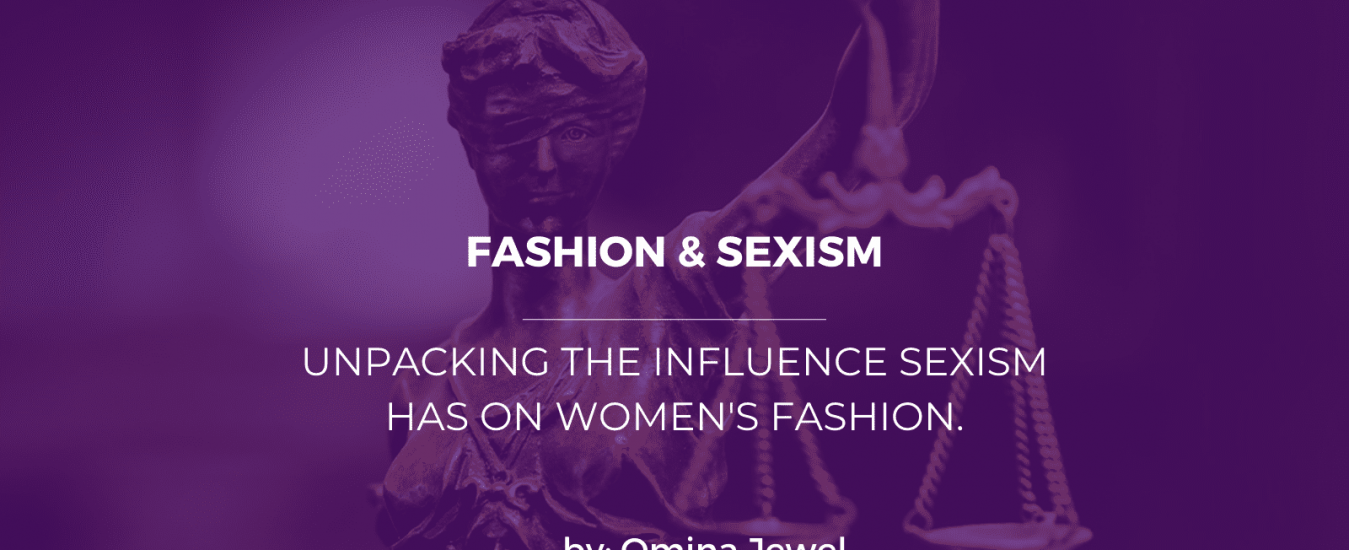Fashion & Sexism
Article by Omina Jewel
Dressing has been gendered for years as people are required by society to dress their parts, parts which are given to us based on the gender binary. Which are male and female. To have a prosperous society, I agree that some rules have to be adhered to by everyone in order to maintain the peace and culture. However, the problem comes in when a particular set of people are more policed, scrutinized and micro managed than others. For women fashion and dressing has always been more than just clothes.
The saying,’ dress how you want to be addressed,’ has been used by society for years to justify the sexual harassment of women in public spaces. The moment the question, ‘how was she dressed?’ is asked, there’s already a problem. As it means we are holding one party accountable for the actions of another. This policing can also be seen when female politicians are scrutinized on what they are wearing on an appearance or debate and male politicians aren’t.
What does not help is the fact that fashion trends for women are mainly prescribed from a male centric lens that does not take into account their needs or comforts but how they appeal and cater to male needs and the male gaze. When most dictators of fashion are heterosexual men, only the gender binary is taken into consideration, women and girls are restricted to certain dress rules at homes, schools and at the work place. How is it that out of the fifty major fashion brands only 14% are run by women. This gap alone tells us who has the final say when it comes to fashion. When women don’t comply to unrealistic standards of fashion they are at risk of being referred to with phrases such as, ‘she let herself go, she’s looking for male attention and validation, her dress was simply asking for it.’
In order to see how fashion can be used as a tool of politics, oppression and sexism have in mind the psychology behind the suffragette uniform, prisoners uniform and what Jews during the holocaust were required to wear by the Hitler regime. Clothes are never just clothes when one group with power is creating the rules and another has to oblige to them voluntarily or not.
When it comes to dress codes in institutions they need to re-examine it to ensure that they are reasonable and equal and their policies cut across all genders without being sexist and sexualizing basic female anatomy such as collarbones and knees. As a society we also need to kill the myth that men are simply just sexual beings who are triggered by the slightest show of skin. This is unfair to them as it is not an accurate representation of the gender as a whole and it enforces the belief that masculinity and hyper sexuality are a mutual concept. Women cannot be truly free when their basic freedom of expression is hindered by outdated misogynistic beliefs.






Comments (7)
lotus365interface
Alright, folks, just checked out lotus365interface. Seems legit, easy to navigate, and got what I needed quick. Give it a shot if you’re looking for this kinda thing. What’s not to like, eh? Check it out here: lotus365interface
33dgamedownload
Yo, 33dgamedownload is my go-to for snagging those game downloads. Super easy to navigate and I’ve always found what I’m looking for. Check it out! 33dgamedownload
q9betlink
Following a link for q9betlink. Seems like a shortcut into the q9bet website. But are these links legit? Worried it might be a phishing attempt. Just saying, be careful out there! q9betlink
tl88
Anyone else using tl88? I appreciate their quick payouts, never had any issues there. Game variety could be better but they have some popular titles. Here’s the link: tl88
Binance账户创建
I don’t think the title of your article matches the content lol. Just kidding, mainly because I had some doubts after reading the article. https://www.binance.com/register?ref=IHJUI7TF
taitranggasv388
Downloaded taitranggasv388 app. So much easier than using the browser. Definitely recommend! Check it out: taitranggasv388
binance-а тркелу
Your point of view caught my eye and was very interesting. Thanks. I have a question for you. https://accounts.binance.info/en-ZA/register?ref=B4EPR6J0